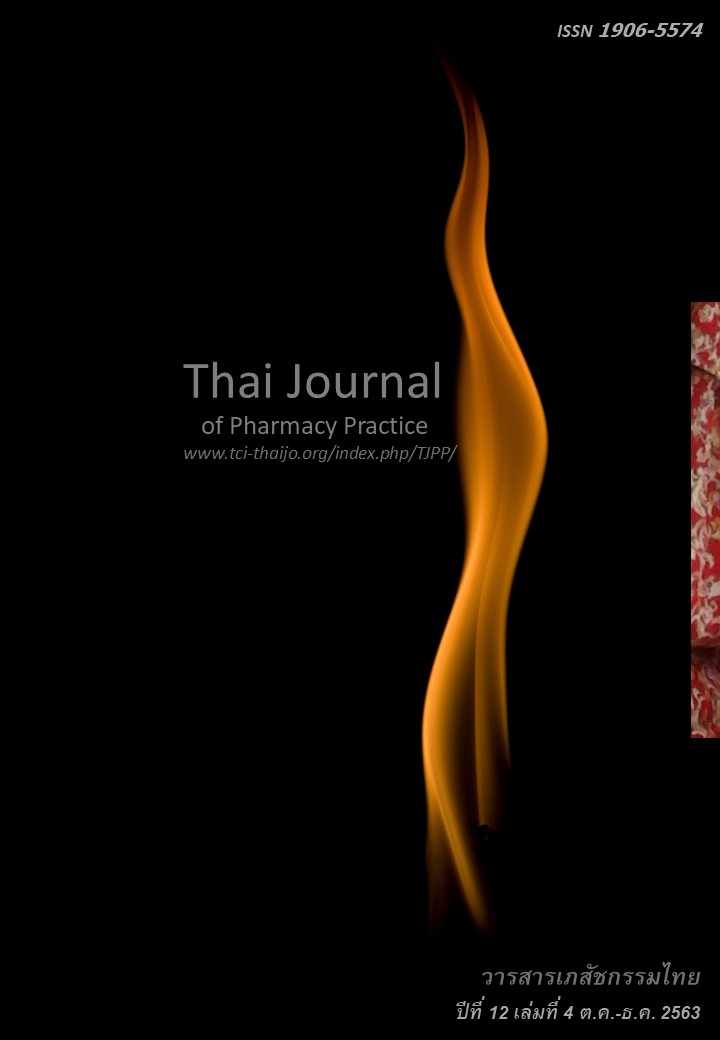ผลของโปรแกรมพัฒนาการรู้เท่าทันสื่อโฆษณาต่อพฤติกรรมการเลือกบริโภคผลิตภัณฑ์สุขภาพในกลุ่มผู้สูงอายุที่ใช้แอปพลิเคชันไลน์ จังหวัดนครนายก
Main Article Content
บทคัดย่อ
วัตถุประสงค์ : เพื่อศึกษาผลของโปรแกรมพัฒนาการรู้เท่าทันสื่อโฆษณาต่อ ความรู้ ทักษะ และพฤติกรรมการเลือกบริโภคผลิตภัณฑ์สุขภาพในกลุ่มผู้สูงอายุที่ใช้แอปพลิเคชั่นไลน์ วิธีการ :การวิจัยครั้งนี้เป็นการทดลองแบบสุ่มและมีกลุ่มควบคุม กลุ่มตัวอย่าง คือ สมาชิกชมรมผู้สูงอายุโรงพยาบาลส่งเสริมสุขภาพตำบลบ้านหนองหัวลิงใน จังหวัดนครนายก ผู้วิจัยจัดแบ่งกลุ่มตัวอย่าง 50 คนด้วยวิธีสุ่มออกเป็นกลุ่มศึกษาและกลุ่มควบคุมกลุ่มละ 25 คน โดยกลุ่มศึกษาจะได้รับโปรแกรมพัฒนาการรู้เท่าทันสื่อโฆษณา เป็นระยะเวลา 4 สัปดาห์ กลุ่มควบคุมได้รับการดูแลตามปกติ ผลลัพธ์ของการศึกษาได้แก่ ความรู้ ทักษะ และพฤติกรรมการเลือกบริโภคผลิตภัณฑ์สุขภาพ ผลการวิจัย : กลุ่มตัวอย่างทั้งสองกลุ่มมีข้อมูลทั่วไปคล้ายคลึงกัน โดยส่วนใหญ่เป็นเพศหญิง (ร้อยละ 82.5) มีอายุเฉลี่ย 64.75 ปี ใช้ไลน์เป็นลำดับแรกในการเข้าถึงสื่อโฆษณาผลิตภัณฑ์สุขภาพทางโซเชียลมีเดีย (ร้อยละ 42.5) โดยมีความถี่ของการใช้งานทุกวัน (ร้อยละ 75.0) สำหรับผลการทดสอบพบว่า คะแนนความรู้เท่าทันสื่อ ผลิตภัณฑ์สุขภาพและการโฆษณาในกลุ่มศึกษาหลังได้รับโปรแกรมดีกว่าก่อนได้รับโปรแกรม (ค่าเฉลี่ย±ส่วนเบี่ยงเบนมาตรฐาน; 13.301.26 และ 7.35
1.75 ตามลำดับ; P < 0.001) คะแนนทักษะในการประเมินโฆษณาผลิตภัณฑ์สุขภาพในกลุ่มศึกษาหลังได้รับโปรแกรมดีกว่าก่อนได้รับโปรแกรม (15.50
1.85 และ 9.50
1.75 ตามลำดับ; P
0.001) และคะแนนพฤติกรรมการเลือกบริโภคผลิตภัณฑ์สุขภาพในกลุ่มศึกษาหลังได้รับโปรแกรมดีกว่าก่อนได้รับโปรแกรม (11.20
1.85 และ 8.00
1.75 ตามลำดับ; P
0.001) สรุป: โปรแกรมพัฒนาการรู้เท่าทันสื่อโฆษณาที่จัดทำขึ้นส่งผลให้ความรู้ ทักษะ และพฤติกรรมการเลือกบริโภคผลิตภัณฑ์สุขภาพของผู้สูงอายุมีประสิทธิผลเพิ่มมากขึ้น
Article Details
ผลการวิจัยและความคิดเห็นที่ปรากฏในบทความถือเป็นความคิดเห็นและอยู่ในความรับผิดชอบของผู้นิพนธ์ มิใช่ความเห็นหรือความรับผิดชอบของกองบรรณาธิการ หรือคณะเภสัชศาสตร์ มหาวิทยาลัยสงขลานครินทร์ ทั้งนี้ไม่รวมความผิดพลาดอันเกิดจากการพิมพ์ บทความที่ได้รับการเผยแพร่โดยวารสารเภสัชกรรมไทยถือเป็นสิทธิ์ของวารสารฯ
เอกสารอ้างอิง
National Statistical Office. Aging population in 2017 [online]. 2019 [cited Jan 9, 2019]. Available from: www.nso.go.th/sites/2014/DocLib14/News/2561/07-61/N10-04-61.pdf.
Nakhon Nayok National Statistical Office. Aging popu lation in Nakhon Nayokprovince [online]. 2019 [cited Jan 9, 2019]. Available from: nknayok.nso.go.th/inde x.php?option=com_content&view=featured&Itemid=435#.
Office of the National Economic and Social Develop ment Council. Annual report 2018 about future Thai land on the green road. Bangkok: Office of the National Economic and Social Development Council; 2014. p.31.
National Statistical Office. Analytical report about factor affecting internet usage among aging in Thai land 2013. Bangkok: Text and General Publication; 2014.
Siriwong P, Unlekjit B. The social media’s using of senior citizens in the market zone of Sam Phran Sub-district, Samphran district, Nakhon Pathom [online]. 2019 [cited Jan 9, 2019]. Available from: repository.rmutr.ac.th/bitstream/handle/123456789/748/rmutrconth_102.pdf?sequence=1&isAllowed=y.
Online News time. Silver age content marketing [on line]. 2019 [cited Feb 10, 2019]. Available from: www. onlinenewstime.com/การตลาดผู้สูงวัยไลน์/.
Somwadsan K, Satararuji K. The study of communication behavior in line application data sharing of elderly people [online]. 2016 [cited Jan 9, 2019]. Available from: www.gscm.nida.ac.th/public-action/%20Proceeding/2559/2.pdf.
Food and Drug Administration. Social media monitor- ing [online]. 2019 [cited Feb 28, 2019]. Available from: 164.115.20.219/oryor2015/news-update-detail.php?cat=&id=694.
Tayati P, Disathaporn C, Onming R. The model of Thai elderly learning management for information and communication technology literacy. Veridian E-Journal Veridian E-Journal, Silpakorn University (Humanities, Social Sciences and arts) 2017; 10: 1456-71.
Srichatrapimook S. Strategy quality of life and learning of disable, aging, and disadvantaged child inconvergence. Bangkok: Research Institute and Counseling; 2016:29-31.
Kaeodumkoeng k, Thummakul D. Health literacy promoting in aging population. Journal of Health Science Research 2015; 9:1-8.
Prentice-Dunn S, Rogers RW. Protection motivation theory and preventive health: beyond the health belief model. Health Educ. Res. 1986; 1: 153-61.
Julawong O. Motivation prevention and health beha viors of the Thai Army conscripts. Journal of the Royal Thai Army Nurses 2014; 15: 28-32.
Phetnui N. Effect of mastering media advertisement program on illegal health supplement among non-communicable disease in primary care cluster [master thesis]. Songkhla: Prince of Songkla Univer sity; 2014.
Lemeshow S, HosmerJr DW, Klar J, Lwanga SK, WHO. Adequacy of sample size in health studies. [online]. 1990 [cited Mar 20, 2019]. Available from: www.who.int/iris/handle/1065/41607.
Chaikoolvatana A, Soontara C. The effect of health education program on high school mastering the media advertisement of dietary supplement among female students in the Northeastern Thailand. Srina garind Medical Journal 2011; 26: 23-31.
NuanprasitS, Wuttipong P, Juntraramanee K. Effect of the video program of self-care knowledge and self -care ability of cataract patients and their caregivers. Journal of Nursing Council 2012; 25: 78-86.
Promwong C. Educational technology and communi cations. Nonthaburi: Sukhothai Thammathirat Univer sity 2000.
Yates BL. Media literacy and attitude change: Asses sing the effectiveness of media literacy training on children’s responses to persuasive messages within the ELM [online]. 2001[cited Mar 11, 2019]. Availa ble from: eric.ed.gov/?id=ED453563.
Buckingham D. Media education literacy learning and contemporary culture [online]. 2003 [cited Mar 1, 2019]. Available from: books.google.co.th /books ?id=vRgNAAAAQBAJ&printsec=frontcover&source=gbs_ge_summary_r&cad=0#v=onepage&q&f=false.
Potter WJ. The state of media literacy. J Broadcast Electron Media 2010; 54: 675-96.
Tansuwannond J. The relationship between adverti- sing media literacy and consumerism behavior of youth in Bangkok. SDU Research Journal Humani ties and Social Sciences 2015; 11: 93-111.


